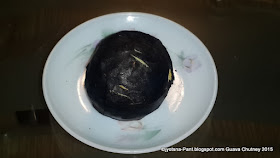 |
| Guava Chutney |
Guava jelly, Guava cheese or Guava
chutney or biting to freshly plucked guava, I love immensely. The sprawling branches of guava tree in our
govt. house used to be laden with fruits from July to March every year and
plucking fresh fruit to make these delicate goodies used to be most delightful.
Of course one or two guavas used to be eaten before even they reached to my kitchen. The joy of plucking fruits from tree and savoring them is beyond
description.
Chutney of guava has a roasted
flavor and the coriander leafs, lemon juice enhances the nutritional value. Guava chutney is a great dip for nachos, pakodas, paranthas or accompaniment with regular
Indian meal (We Indiand are very fond of chutney).
Preparation Time: 5 minutes
Cooking Time: 4-5 minutes
(Roasting of Guava)
Servings: 100 gm. Chutney
(Approx.)
Nutritional value: (Approximate values)
Cal.: 115
Total fat: 1..42 gm
Potassium: 625 mg
Sodium: 3mg
Carbs: 23gm
Dietary fibers: 69gm
Sugars: 15 gm
Protein: 8 gm
Micro nutrients Vitamin A, Vitamin
C, calcium, Iron
Ingredients Required For making
Guava Chutney:
- 150 gm. Guava (1 Medium size)
- 1 Teaspoon freshly squeezed Lemon Juice
- 4-5 Sprigs of Coriander leafs
- 1-2 Green Chilies (To taste)
- Salt to taste
- Directions For Making Guava Chutney:
- Wash and pat dry Guava.
- Poke the guava with a fork and roast it on gas/oven till the outer cover of guava tirns black and it becomes soft. The juices will start coming out from the places you had poked it.
- Let the roasted guava cool. During cooling the internal heat of guava will cook it further.
 |
| Roasted Guava |
- Remove the blackened peel and give a wash to ensure all black is gone.
 |
| Roasted and Peeled Guava |
- Mas the cooked and cleaned guava and pass the mashed guava through a sieve, till all mashed pulp is collected and seeds are separated.
 |
| Roasted Guava Pulp to be used for chutney |
- Discard the seeds.
 |
| Roasted Guava seeds to be discarded |
- Wash coriander leafs and shred them. Cut the chilies to pieces.
- Take
- Guava pulp
- Coriander leafs
- Green Chilies
- Salt
- Add the freshly squeezed lemon juice, and mix. (Do not pulse after adding lemon juice).
- Store the chutney in a glass container. It can be stored for 15 days in fridge.
 |
| Guava Chutney |
- Enjoy Guava Chutney with Indian Stuffed paranthas/nachos/fried chicken/Fish and chips. The fruity flavor with tang of lemon makes the whole experience worth it.
Tips:
- Poke guava before roasting so that the steam formed in it during roasting escapes, and ensuring guava getting cooked right up to the core.
- Do not try to peel the guava while it is hot, as this may cause hand getting burnt.
- While peeling the roasted guava put it under running water for easier peeling.
- The guava chosen for making chutney should be soft not hard.
- When guavas are kept too long on shelf then they do not taste too good to eat, these can be made to chutney.
- Check the hotness of green chilies and the sourness of the lemon juice before adding because too hot and sourn will spoil the fruity taste of chutney.
- Do not pulse after adding lemon juice as the chutney will develop slight bitter atste.
Suggested Variations:
- Instead of roasting guava can be boiled to softness and mashed without peeling, but the roasted flavor will be surely missing and much nutients will get leached into water while boiling.
- If you feel the chutney has turned little sourer than your liking then add 1 teaspoon of powder sugar to it and mix.
- Coriander sprigs can be replaced by 5-6 leafs of fresh mint. Since mint has a strong taste thus just too many leafs will over power the flavor of guava.































